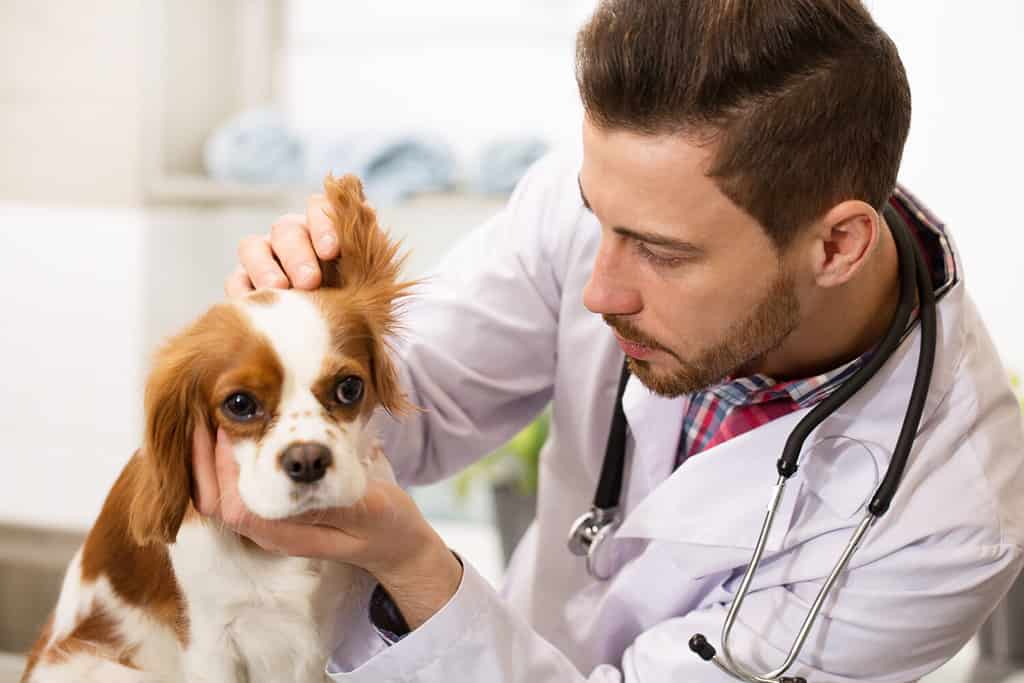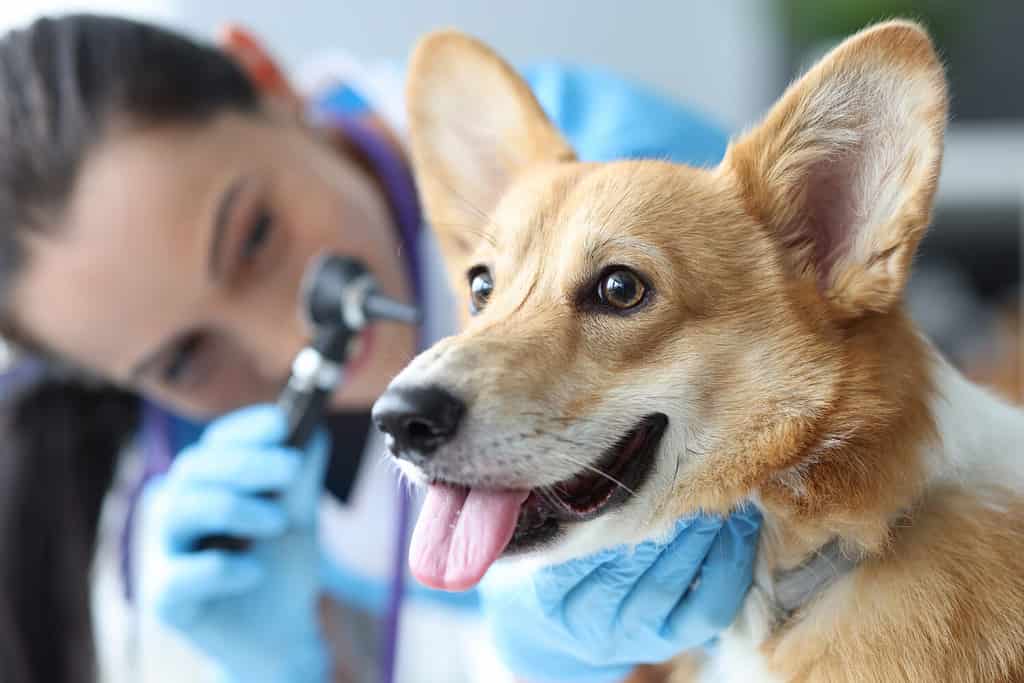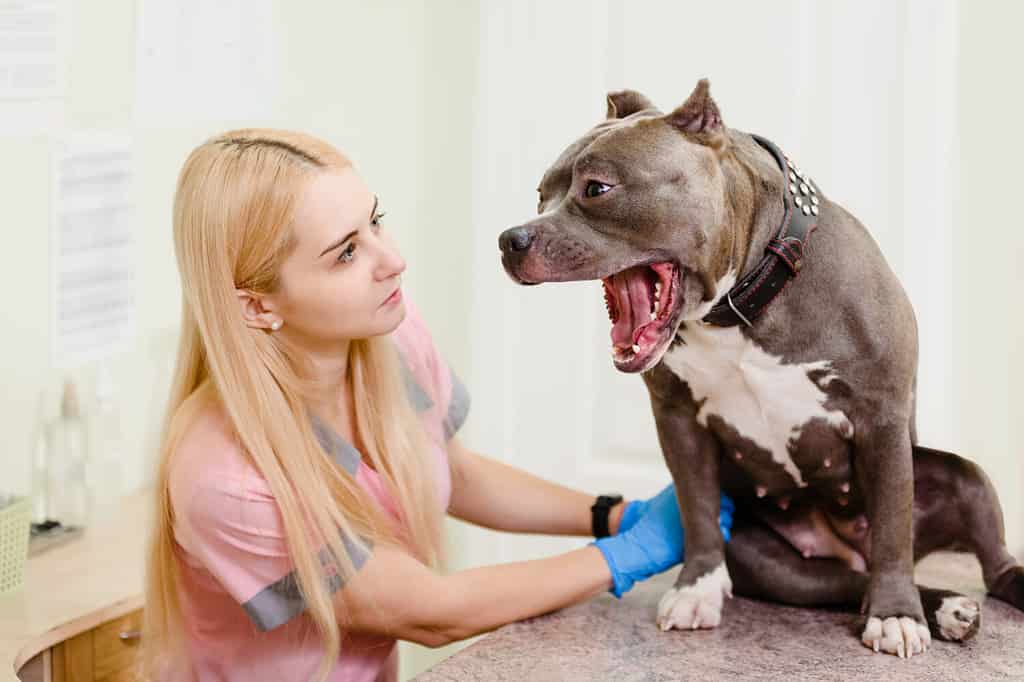Buying or adopting a dog adds an exciting, furry member to your family. Just like with children, though, dogs need vaccines to stay healthy and avoid disease. Some vaccines that dogs receive are absolutely necessary while others are probably a good idea to get but up to the owner’s discretion based on their dog’s health needs and lifestyle. Vaccines also cost money, and new puppy parents can expect to visit the vet several times in their dog’s first year to stay up-to-date on the vaccine boosters.
Discover more about the types of shots puppies need, the non-core vaccines to give your dog, and the costs of these dog vaccines in 2024.
What Shots Do Dogs Need?

Puppies need vaccines early in life to build up immunities and grow healthily.
©Nestor Rizhniak/Shutterstock.com
A few dog vaccines exist that every puppy should get to preserve and maintain their health. Many of these vaccines can be given at an early age. However, if you adopt your dog from a shelter and they have no medical history, they’re usually able to receive these vaccines too.
At the Age of Six to Eight Weeks
At six to eight weeks, puppies are just starting to socialize with their mom and siblings. They’ve started walking, are finding their bark, and learning how and when to use their teeth. Early training and socialization remain crucial at this age to raise a well-adjusted pup.
While your puppy has received some antibodies from its mother via her milk that help fight against disease, they’re wearing off around this age. As such, vets recommend two core vaccines for six to eight-week-old puppies: distemper and parvovirus. Both are damaging viruses that can result in death if not properly prevented.
Distemper
Canine distemper is often fatal and has no cure, so vaccination is a must. In dogs, the distemper virus can (and will) affect the nervous, respiratory, and gastrointestinal systems resulting in symptoms like:
- Discharge from the eyes.
- Diarrhea.
- Coughing.
- Muscle twitches, head tilts, and convulsions.
- Vomiting.
- Paralysis.
Dogs get the distemper virus from airborne sources, like sneezes or coughs from an infected animal. Any dog that survives with distemper usually has irreparable nervous damage.
The canine distemper vaccine works by building up immunity in puppies as their systems develop. It’s a series of vaccines that should be given without gaps in the immunization schedule.
Parvovirus
This gastrointestinal virus is highly contagious and can live for long periods of time in the environment thanks to its scary resistance to heat, cold, drying, and humidity. The virus mostly travels through dog-to-dog contact but can spread by touching dogs, collars, leashes, kennel surfaces, and clothing that has come into contact with the infected dog. Dogs suffering from parvovirus show symptoms including:
- Severe, bloody diarrhea.
- Vomiting.
- Abdominal pain.
- Lethargy.
Similar to distemper, parvovirus does not have a cure. Instead, the best prevention technique is vaccination at an early age.
Both distemper and parvovirus require more than one shot for full immunity. Owners should ensure the vaccine schedule they set with the vet remains intact, as skipping or missing immunizations can render the vaccine less effective.
At the Age of 10-12 Weeks
Puppies nearing three months of life are like sponges — they’re getting into everything they can to explore and discover their world. With growing independence and hypersensitivity to change, 10 to 12-week-old puppies should start acclimating to their new environment. Owners can strive during this age range to make the majority of the puppy’s interactions positive, comforting, and safe.
At this age, puppies will get their second doses of distemper and parvovirus vaccines, in addition to vaccines for adenovirus and parainfluenza. These four vaccines are given together in what’s known as “DHPP” or “DAPP” which stands for distemper, adenovirus (also known as hepatitis), parainfluenza, and parvovirus.
Adenovirus in dogs
Two types of adenovirus are commonly found in dogs: canine adenovirus type 1 (CAV-1) and canine adenovirus type 2 (CAV-2). There is no cure for either version, but hospitalization for CAV-1 can support a dog’s immune system to fight infection and lessen the severity of symptoms.
Most vaccinated dogs, if they contract an adenovirus, will become infected with CAV-2. It’s more common and only causes some respiratory issues, while CAV-1 is a serious and sometimes fatal liver disease. If your dog contracts and survives CAV-1, it will most likely have a lifetime immunity to it.
Dogs contract CAV-1 through direct contact with an infected dog’s urine, feces, or other bodily discharge. Unfortunately, CAV-2 is even easier to contract — simply sniffing at an infected dog on a walk or breathing in an infected dog’s cough can infect your dog with CAV-2.
Parainfluenza in dogs
Parainfluenza is an easily preventable disease similar to canine distemper. If you’re thinking “the flu for dogs,” you’re mostly right. Canine parainfluenza is a respiratory disease that can turn serious quickly if care and quarantine are not provided.
In dogs, parainfluenza will affect dogs with a cough (which sometimes turns into coughing up blood), nasal discharge, lethargy, and a general change in attitude.
Thankfully, parainfluenza does have approved antibiotics to help treat the disease. However, vaccination is key to preventing the spread of this highly contagious disease.
After 12 Weeks
By three to four months of life, puppies should have had at least their first shot in the series of DHPP vaccines. The only one left to begin is rabies.
Rabies in dogs is an incurable viral disease that affects the neurological system. Because rabies has no cure and is often fatal in dogs, the rabies vaccine is one of the only true methods to protect your pup from the viral infection.
Receiving the rabies vaccine is especially important for any dog whose lifestyle includes long periods outside or around other potentially infected animals.
Every One to Two Years
The DAPP/DHPP usually needs boosters after a year. In addition to the rabies booster discussed below, this set of four is the only core vaccine package your pup should need after their first year of life.
Every Two to Three Years
For most states in America, dogs are legally required to receive a rabies vaccine every few years. Depending on your vet, your dog’s rabies vaccine may need a booster every year, every two years, or every three years. If you don’t keep up with your dog’s rabies vaccine and a bite incident with another person occurs, it might spell trouble for you and your pup.
Non-Core Vaccines

Depending on your dog’s lifestyle, they made benefit from vaccines that keep them safe while traveling or playing with others.
©Rosa Frei/Shutterstock.com
While not required by vets or by law, several other vaccines exist that can positively influence your dog’s health, including:
- Bordetella.
- Influenza.
- Leptospirosis.
- Lyme disease.
- Coronavirus.
- Giardia.
Bordetella may not make it onto the list of core vaccines for a vet, but it’s a smart idea to vaccinate your dog(s) for it anyway — especially if you know you’ll want to board them at some point in the future. Bordetella, the main cause of “kennel cough” in dogs, is a type of bacteria that negatively affects a dog’s respiratory system. It’s transmitted quickly and easily through airborne means, especially in environments where many dogs are in a confined space with each other (like dog daycare, kennels, and training classes). Often, reputable boarding hotels and daycares will require proof of Bordetella vaccination before accepting your dog.
Did you know more than one type of influenza exists for dogs to contract? In addition to parainfluenza, dogs can contract two strains of canine influenza: H3N2 and H3N8. Both are contagious viral infections able to be prevented with a bivalent vaccine.
“Lepto and Lyme” is a term often heard by dog owners when speaking about the noncore vaccines for Leptospirosis and Lyme diseases. Both are highly preventable bacterial diseases. Leptospirosis is also zoonotic, meaning it can pass between species (from dogs to humans), making it all the more important to protect your dog and yourself.
The “coronavirus” in dogs has nothing to do with COVID-19. Instead, it’s a bacterial disease that affects a dog’s gastrointestinal and respiratory systems.
Finally, giardia is a potentially life-threatening parasite that can cause severe diarrhea and weight loss. It’s easily contracted through sharing water bowls or coming into contact with the feces of another infected dog.
Cost of the Vaccines

Vaccine costs vary by vet and animal size.
©megaflopp/Shutterstock.com
As with nearly every product and service, the cost of dog vaccines will vary based on the region, veterinarian, and size of the dog. Vaccines tend to range between $20 and $55 a shot, with outliers on either side.
Owners can predict the average cost of dog vaccines in 2024 with the ranges below according to Market Watch Guide’s research.
- Distemper. Usually costs between $33 to $39 and is considered as part of the DAPP/DHPP.
- Parvovirus. As part of DAPP/DHPP, it costs around $33 to $39.
- Adenovirus. This costs around $33 to $39 as part of the DAPP/DHPP.
- Parainfluenza. Usually combined with three other vaccines to complete the DHPP/DAPP, this costs between $33 to $39.
- Rabies. Costs around $23 to $28 per shot.
- Bordetella. The vaccine and additional boosters cost around $28 to $33.
- Influenza. By far the most expensive vaccine, this will cost somewhere between $45 to $52.
- Leptospirosis. Costs between $20 and $24 dollars in most states.
- Lyme disease. Will cost between $36 and $43 dollars.
How to Pay for Dog Vaccines
Many vets will charge an exam fee with the vaccine, so remember that you’ll pay for both the visit and the shot or booster. Some cities and neighborhoods have shelters, rescues, or humane societies that will hold a no- or low-cost vaccine clinic for the community. Other options include choosing a vaccine package that discounts when you purchase and administer several vaccines together and opting for pet insurance. Pet insurance costs a monthly premium but tends to lower the overall costs of vet visits and medication.
Things to Consider About Dog Vaccinations

Remember that vaccines prevent, not cure, common dog diseases.
©Denys Kurbatov/Shutterstock.com
Each dog has different health issues and owners are responsible for understanding and catering to those needs. Some considerations to think about when discussing dog vaccinations with your vet:
- Lifestyle. Ensure your vet understands your and your dog’s lifestyle so they can recommend the best course of vaccination. If you travel often with your dog, they need more (and different) vaccines — like a rattlesnake vaccine.
- Chronic conditions or immunocompromisation. Some conditions contraindicate dogs from receiving vaccines or render vaccine antibodies useless.
- Complications. Ask your vet what to do if complications arise after your pup receives a vaccine. Often, they’ll request you bring him or her back to the office for a check-up, and you both will strategize another route for protection.
- Age and background. Maybe you’ve adopted your dog from the shelter and for one reason or another, they haven’t received any vaccines. Ensure your vet knows so they can run blood tests and have an accurate benchmark of your dog’s current health status before administering vaccines.
- Additional prevention methods. Vaccines aren’t foolproof methods of immunity, so owners can practice caution by understanding the additional ways to prevent infection of the worst canine viruses and diseases.
Keep Your Dog Safe Their Whole Life
As your furry friend grows, their health needs will evolve. Consult your veterinarian on your dog’s vaccination schedule after completing their first-year puppy vaccines — and exercise caution when bringing your dog around other animals you don’t know well. Depending on their lifestyle and health issues, more or less vaccines may be necessary to ensure a long, happy life.
The photo featured at the top of this post is © StrDr stock/Shutterstock.com
Ready to discover the top 10 cutest dog breeds in the entire world?
How about the fastest dogs, the largest dogs and those that are -- quite frankly -- just the kindest dogs on the planet? Each day, AZ Animals sends out lists just like this to our thousands of email subscribers. And the best part? It's FREE. Join today by entering your email below.
Sources
FAQs (Frequently Asked Questions)
What shots does my dog need annually
- Rabies.
- Canine parvovirus.
- Distemper.
- Canine hepatitis.
Do indoor dogs need vaccinations
It is a myth that dogs who live indoors do not need to be vaccinated against infectious diseases. While living an indoor lifestyle is certainly safer overall than living outdoors, and indoor living contributes to a longer life expectancy, important infectious diseases can find indoor dogs.
What happens to a dog without shots?
Can dogs live without vaccines?
Dogs can live perfectly well without shots and it is the personal decision of the dog owner as to whether to get the dog inoculated or not. However, if you do decide not to have your dog inoculated you may be putting it at increased risk of contracting certain conditions that could, in effect, pose a risk to its life.
Thank you for reading! Have some feedback for us? Contact the AZ Animals editorial team.







